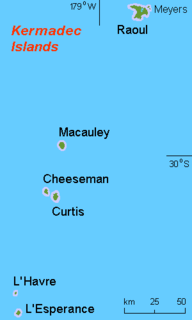
The little shearwater is a small shearwater in the petrel family Procellariidae. Despite the generic name, it is unrelated to the puffins, which are auks, the only similarity being that they are both burrow-nesting seabirds.

Raoul Island, the largest and northernmost of the main Kermadec Islands, 900 km (560 mi) south south-west of 'Ata Island of Tonga and 1,100 km (680 mi) north north-east of New Zealand's North Island, has been the source of vigorous volcanic activity during the past several thousand years that was dominated by dacitic explosive eruptions.

The Kermadec Islands are a subtropical island arc in the South Pacific Ocean 800–1,000 km (500–620 mi) northeast of New Zealand's North Island, and a similar distance southwest of Tonga. The islands are part of New Zealand, 33.6 km2 (13.0 sq mi) in total area and uninhabited, except for the permanently manned Raoul Island Station, the northernmost outpost of New Zealand.

Jean-Michel Huon de Kermadec was a French Navy officer. He took part in voyages of exploration in the Pacific Ocean under Bruni d'Entrecasteaux, looking for the lost expedition of Jean-François de La Pérouse.

Parma is a genus of damselfish in the family Pomacentridae.

The Kermadec Trench is a linear ocean trench in the south Pacific Ocean. It stretches about 1,000 km (620 mi) from the Louisville Seamount Chain in the north (26°S) to the Hikurangi Plateau in the south (37°S), north-east of New Zealand's North Island. Together with the Tonga Trench to the north, it forms the 2,000 km (1,200 mi)-long, near-linear Kermadec-Tonga subduction system, which began to evolve in the Eocene when the Pacific Plate started to subduct beneath the Australian Plate. Convergence rates along this subduction system are among the fastest on Earth, 80 mm (3.1 in)/yr in the north and 45 mm (1.8 in)/yr in the south.
Enneapterygius kermadecensis, the Kermadec triplefin, is a fish species in the family Tripterygiidae, found in tidal rock pools around the Kermadec Islands in the southwest Pacific Ocean. Its length is up to 3.3 cm.
Alsophila kermadecensis, synonym Cyathea kermadecensis, is a species of tree fern endemic to Raoul Island in the Kermadec Islands, where it is locally common in damp, and sometimes drier, forest and scrub. The trunk of this plant is erect, slender, and up to 20 m tall. It is often covered with scars of old stipe-bases. Fronds are tripinnate and up to 4 m in length. The rachis and stipe are both brown in colouration and bear basal scales that are brown, glossy, and often twisted. Sori are borne on either side of the pinnule midvein. They are covered by hood-like indusia.

Metrosideros kermadecensis, with common names Kermadec pōhutukawa and New Zealand Christmas bush is an evergreen tree of the myrtle family which is endemic to the volcanic Kermadec Islands about 900 km north-east of New Zealand. The tree produces a brilliant display of red flowers, made up of a mass of stamens and is the dominant forest tree on Raoul Island, growing to 15 m or more. The trunk is up to 1 m or more in diameter. It is very similar to, and often confused with, the pōhutukawa of mainland New Zealand, differing mainly by having smaller, more oval leaves, and by flowering throughout the year. It also resembles the ʻōhiʻa lehua of Hawaiʻi.

The Kermadec-Tonga subduction zone is a convergent plate boundary that stretches from the North Island of New Zealand northward. The formation of the Kermadec and Tonga Plates started about 4–5 million years ago. Today, the eastern boundary of the Tonga Plate is one of the fastest subduction zones, with a rate up to 24 cm/yr. The trench formed between the Kermadec-Tonga and Pacific Plates is also home to the second deepest trench in the world, at about 10,800 m, as well as the longest chain of submerged volcanoes.

Conus kermadecensis, common name the Kermadec cone, is a species of sea snail, a marine gastropod mollusk in the family Conidae, the cone snails and their allies.
Notoliparis kermadecensis is a species of snailfish (Liparidae) that lives in the deep sea. Endemic to the Kermadec Trench in the Southwest Pacific, it is hadobenthic with a depth range between 6,474 and 7,561 m (21,240–24,806 ft), and can reach a standard length of up to 25.8 cm (10.2 in).
Notoliparis is a genus of fish in the family Liparidae found in the Atlantic, Pacific and Southern Ocean.
C. kermadecensis may refer to:
The blackbelly triplefin is a species of triplefin blenny in the genus Enneapterygius, described by German ichthyologist Ronald Fricke in 1997 and known from the western Pacific Ocean.
Dorphinaxius kermadecensis is a genus of mud lobster native to the Norfolk Island, parts of New South Wales, and the Kermadec Islands of New Zealand. It is the only species in the genus Dorphinaxius. It has a depth range of 0–8 metres (0–26 ft).
Bolma kermadecensis is a species of sea snail, a marine gastropod mollusk in the family Turbinidae, the turban snails.
Leptothyra kermadecensis is a species of small sea snail with calcareous opercula, a marine gastropod mollusk in the family Colloniidae.
Octopus kermadecensis is a species of octopus in the genus Octopus. It is endemic to the Kermadec Islands. It was first described as Poypus kermadecnsis in 1914 from a female specimen, no male specimen was collected and described until 2011.









